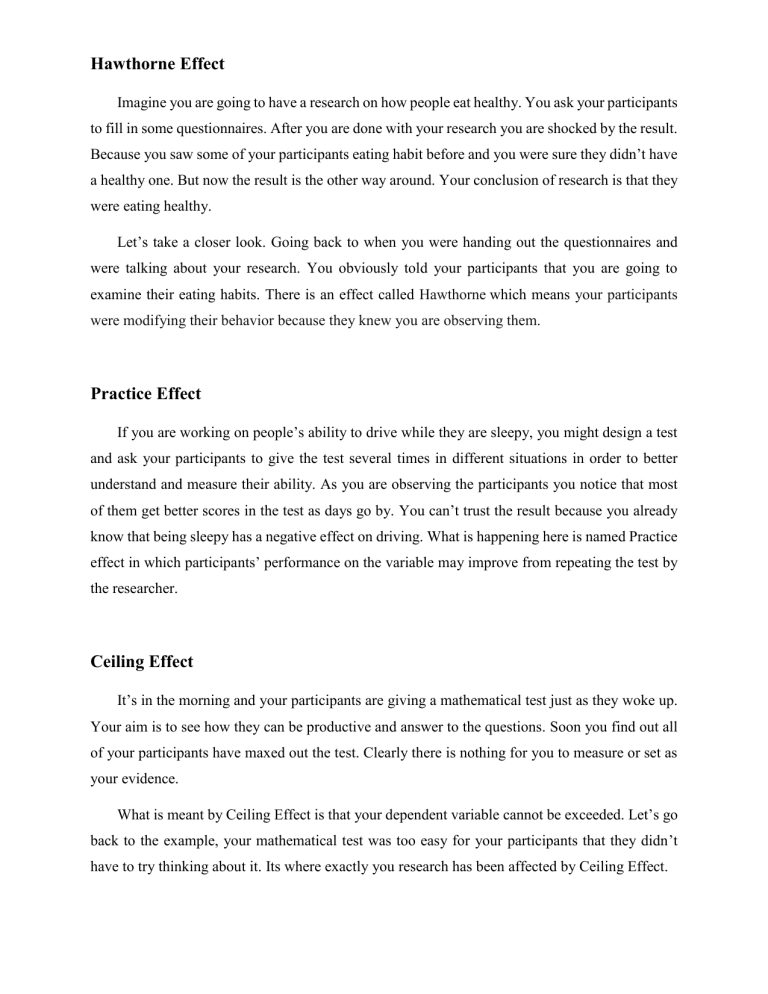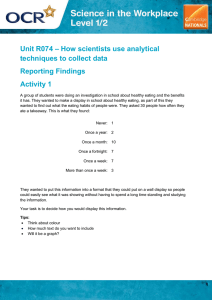
Hawthorne Effect Imagine you are going to have a research on how people eat healthy. You ask your participants to fill in some questionnaires. After you are done with your research you are shocked by the result. Because you saw some of your participants eating habit before and you were sure they didn’t have a healthy one. But now the result is the other way around. Your conclusion of research is that they were eating healthy. Let’s take a closer look. Going back to when you were handing out the questionnaires and were talking about your research. You obviously told your participants that you are going to examine their eating habits. There is an effect called Hawthorne which means your participants were modifying their behavior because they knew you are observing them. Practice Effect If you are working on people’s ability to drive while they are sleepy, you might design a test and ask your participants to give the test several times in different situations in order to better understand and measure their ability. As you are observing the participants you notice that most of them get better scores in the test as days go by. You can’t trust the result because you already know that being sleepy has a negative effect on driving. What is happening here is named Practice effect in which participants’ performance on the variable may improve from repeating the test by the researcher. Ceiling Effect It’s in the morning and your participants are giving a mathematical test just as they woke up. Your aim is to see how they can be productive and answer to the questions. Soon you find out all of your participants have maxed out the test. Clearly there is nothing for you to measure or set as your evidence. What is meant by Ceiling Effect is that your dependent variable cannot be exceeded. Let’s go back to the example, your mathematical test was too easy for your participants that they didn’t have to try thinking about it. Its where exactly you research has been affected by Ceiling Effect. Pilot Study Take this as an example: you want to see how customers all around the world respond to a rude shopkeeper. For that you need to make sure every of the shopkeepers say the same thing and have the same situation which increases the amount of errors in your research. What might come to your mind is that if you practice with shopkeepers early before the actual research and have them rehearsal the situation you will get less errors in your data collection. What you did here is simply called Pilot Study. Which is a trial before the actual research. Attrition You aim to study how EFL leaners respond to a specific method and what they will achieve. In this process which is a long time research you test your participants several times. In during the research, you see reduction in the number of your participants. You ask them why they are not continuing the study and they answer that they don’t want to anymore. This reduction will affect your result and is called Attrition. So in your research you need to mention your Attrition ratio. Cohort Study Let’s go back to the pervious example where we were studying EFL learners. In this study if we keep observing and studying the participant in long period and see how they exposed to different factors which may affect their lives we are doing Cohort study. By that we can look at many different aspects of people’s lives, for example their anxiety. Cohort studies can be prospective (collecting data as individual lives), or retrospective (after a certain outcome). Trend Study Imagine you are curious about English teachers’ attitudes toward the use of flipped classroom. You want to generally see if there is any trend in their attitudes. For this reason, you keep studying them over 3 years. In this period of time your participants change and you question them from different perspectives. In this situation you are following a type of research design called Trend Study.



